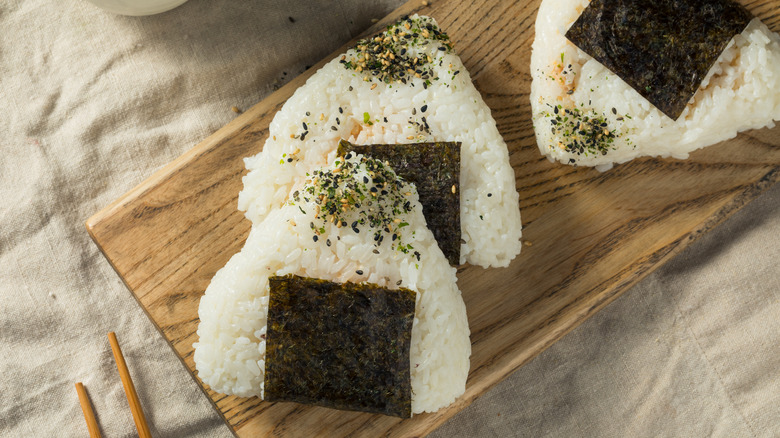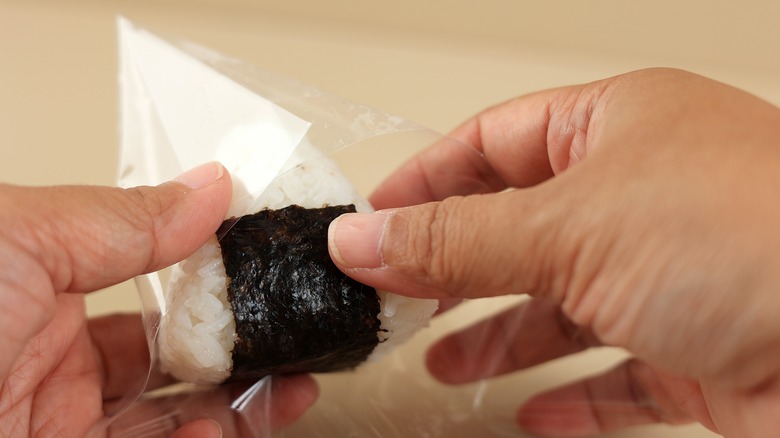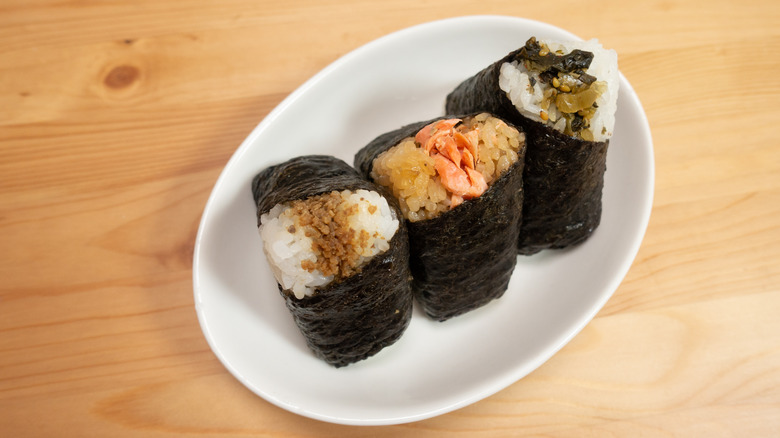The Plastic Wrap Hack That Prevents Soggy Onigiri
Onigiri is a beloved snack for many Japanese and Japanophiles. It is essentially a piece of compressed rice, its name originating from the Japanese word "nigiru", which means "to grasp" or "to squeeze". It comes in many flavor varieties, with or without filling, usually with a piece of nori (Japanese seaweed) enveloping part or all of it. This nori is best enjoyed dry for a satisfying crispy bite, but as cooked rice is quite moist, any nori that comes into contact with it will eventually turn soggy. This can be prevented by eating the onigiri as soon as it is made or by serving the nori sheets separately so that the eater can wrap the onigiri themselves if they wish to eat it later.
But keeping a separate sheet of nori is not always practical. In Japanese convenience stores, onigiri comes wrapped in a sort of plastic envelope that cleverly separates the nori from the rice while also keeping the rice from drying out. This piece of Japanese ingenuity is incredibly clever, and Oh!Nigiri on TikTok has come up with a DIY version of this plastic wrap for those who prepare their own onigiris. Check out her hack below:
@ohh_nigiri Onigiri Hack #cookinghack #cookinghacktips #ricehack #riceballs #riceballer #onigiri #japanesecooking #japanesehomecooking #noriseaweed #foodvlogger #healthysnackideas #crispynori
♬ Japanese Classical Music, Festival, Gagaku – Osamu Yamazaki
Isn't that nifty? Now you can pack onigiri to go while ensuring crisp nori every time.
Making sure it all sticks together
While you could get yourself a pack of onigiri wrappers from a specialty store, that only really makes sense if you foresee yourself making them at least a few times a week. The more economical way is to hack it with what you already have at home — in this case, regular plastic wrap.
Apart from keeping the nori crispy and the rice moist, the wrapper also helps hold the rice in shape. Structure is integral for onigiri, and that begins with preparing the rice itself. Sushi rice, such as calrose rice, is perfect for making onigiri. It is a medium-grain rice that is just the right amount of sticky to be formed without having to be mashed together. Preparing rice for onigiri is much like preparing rice for sushi, such as nigiri sushi. The only difference is that onigiri rice is not flavored with sushi vinegar, which is a kind of sweetened rice vinegar.
Once the rice is prepped and the filling has been incorporated, the rice can then be formed into different shapes. The triangular shape is the most widely recognized and is the shape that suits the plastic wrap hack best. That said, onigiri can also be formed into balls, patties, or cylindrical shapes, which are then stuffed with various fillings.
Different types and flavors of onigiri
Onigiri can be flavored or filled in a variety of ways. Traditionally, rice balls are filled with a salty ingredient like umeboshi (a type of salty pickled plum) or grilled salted salmon. In Japanese convenience stores, you can find a whole variety of flavors. Unagi (grilled eel), fish roe, and even tuna flakes with mayonnaise are now often available as onigiri fillings.
Another way to flavor onigiri is by not filling them at all but instead sprinkling the surface with plain seaweed flakes or, more commonly, a type of Japanese topping called furikake. It is a combination of seaweed flakes with sesame seed, salt, and other ingredients like dehydrated fish, making it a super-savory and crunchy seasoning. You can also mix the furikake into the rice before shaping it, distributing the flavor more evenly. Take this mixed-rice onigiri concept a step further by finely chopping up any of the filling ideas above (salmon or umeboshi work particularly well) and mixing that into the rice before shaping it. Just remember not to use any particularly oily ingredients, or the onigiri will not hold together.


